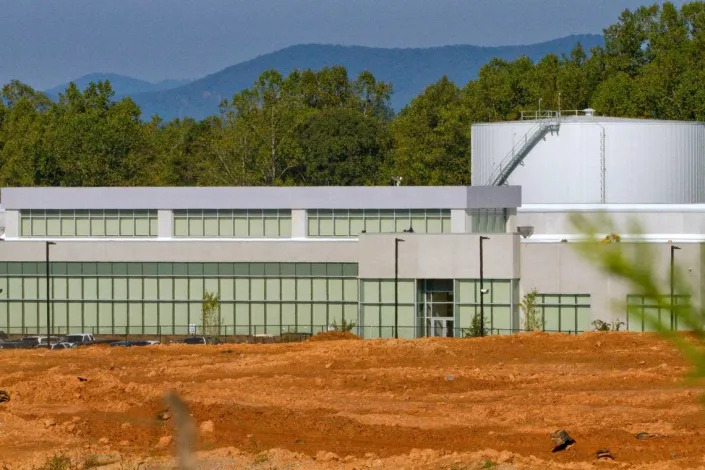
Duke Energy knows that cutting carbon levels by 2030 means retiring more coal plants and building more solar farms. After that, the future becomes murkier, and officials at the company’s highest levels think that hydrogen, a long-studied fuel with little widespread use, could be part of the answer.
In late October, Lynn Good, Duke’s CEO, touted hydrogen’s promise in a conversation with former U.S. Energy Secretary Ernest Moniz, saying, “We can make real progress on technical feasibility and also on tackling cost competitiveness so that as we get to the 2030s, it becomes a really valuable tool to reach net zero.”
For utility companies, hydrogen’s potential is clear: It burns completely free of greenhouse gas emissions, resulting only in water or vapor. And companies have started researching how much hydrogen they can blend with natural gas in order to use existing pipelines and distribution network to sell what they call a cleaner product, with Dominion Energy currently pursuing a pilot project in North Carolina.
But skepticism about hydrogen remains high. While hydrogen burns cleanly, the process to separate the gas from other substances — particularly natural gas — does result in carbon dioxide emissions. And some question whether utilities can use hydrogen as an excuse to continue investing in gas infrastructure instead of renewable sources.
“That’s kind of the main crucial question about hydrogen: Where do you get that hydrogen from — how do you make it? And I think the answer to that question would really tell you how environmentally beneficial it is, economically viable it is, how clean it is and so on,” said Nico Hotz, a Duke University professor who has studied hydrogen generation for more than a decade.

Nearly all of the hydrogen in use today is “gray hydrogen,” which is created by treating natural gas and results in carbon dioxide emissions in addition to hydrogen. Much of the research focus, however, including a project announced by the U.S. Department of Energy this summer, is on “green hydrogen” in which the gas is separated from water using electricity generated by renewable sources.
Some also question how widespread the use of hydrogen should be. While utilities like Dominion Energy tout hydrogen as the “Swiss army knife of clean energy,” environmental groups like the Natural Resources Defense Council say the powerful fuel should be used in a more targeted way, with hydrogen fuel cells decarbonizing the shipping industry or steel plants.
“Are you using it sparingly, which has great potential? Or are you using it expansively just because you want to perpetuate the use of some form of gas in the system?” said Rachel Fakrah, a policy analyst in the Natural Resources Defense Council’s climate and clean energy program. “This is, I think, a tension point that we’re seeing in the hydrogen space currently between these two very different visions for this energy resource.”
Hydrogen use by Duke Energy and Dominion
A Dominion Energy training site in Gastonia could be the site of the Virginia utility’s second hydrogen pilot program. The utility’s rate case under review by the N.C. Utilities Commission includes a pilot program that would see the utility test a blend made of 95% natural gas and 5% hydrogen, similar to a blend of gasoline and ethanol.
The pilot would allow Dominion to see how hydrogen affects pipes, whether it still shows up on leak detection systems and how it affects customers’ appliances, said Aaron Ruby, a Dominion spokesman. A similar pilot in Utah earlier this year was successful, and the company is exploring using the blend in a small part of its Utah service system.
“Hydrogen has the potential to enable broad, economy-wide decarbonization that we’re going to need to see if we’re going to address climate change,” Ruby said, adding that it could be used to reduce emissions not only from electricity and natural gas but also from manufacturing and transportation.
Right now, Dominion is using gray hydrogen, sourced from natural gas with carbon dioxide emissions in the separation process. Long-term, Ruby said, the utility intends to shift to green hydrogen, using water and renewable energy.
“We’re trying to get ahead of the technology, fully understand it, gain all of the experience and knowledge that we need, so when green hydrogen is available we’re ready to go,” Ruby said.
Duke Energy, North Carolina’s largest utility, hasn’t yet embarked on any pilot projects. But the Charlotte-based utility has announced a research partnership with Siemens Energy and Clemson University that will use electrolysis to produce hydrogen from water using electricity generated by renewable sources and investigate how to store the gas.
Green hydrogen is most likely Duke’s path forward in the Carolinas, said Sara Adair, Duke’s director of public policy.
“Blue hydrogen” — hydrogen that is separated from natural gas and the resulting carbon dioxide is captured and stored — is difficult because of the Carolinas’ geography, according to Adair. And the utility’s existing energy mix, which is heavy on carbon-free nuclear and renewables, lends itself to green hydrogen.
Duke considers hydrogen one of several technologies that could provide a reliable source of fuel when the sun isn’t shining or the wind isn’t blowing. Other technologies considered in the same vein are small advanced nuclear reactors, long duration storage and potentially carbon capture.
“Think about seasonal shifts in energy — moving solar from sunny October days to cold October mornings, and that’s where these technologies become increasingly important,” Adair said, adding that hydrogen could also provide a way to store excess renewable energy.
In a 2020 climate document, Duke outlined a vision in which the new technologies — be they hydrogen or advanced nuclear generation — produce about 16% of its power by 2040 and 30% as part of a net zero fleet in 2050.
Right now, the price of green hydrogen is part of what’s holding the technology back. Duke estimates a blend of 80% natural gas and 20% green hydrogen would be about twice as expensive as natural gas.
Factors that could bring price down, Adair said, include the price of renewable energy continuing to drop and electrolyzers that split the hydrogen from water becoming more efficient. Company officials hope projects like the one they are launching at Clemson will help.
“We see a need for these technologies to be deployed at scale by the mid-2030s,” Adair said, “but in order to get there we need to be doing the research and development and piloting and moving up that learning curve and down the cost curve today.”
How should hydrogen be used?
Fakrah calls much of the widespread excitement about hydrogen “hype” and is mainly worried that utilities will try to market its widespread use as an energy source in an effort to continue investing in natural gas turbines and infrastructure. That infrastructure is increasingly under fire from climate advocates and scientists who are concerned about natural gas’ emissions of methane, an extremely powerful greenhouse gas that doesn’t last in the environment as long as carbon dioxide.
Many natural gas turbines can already fire a blend containing some hydrogen, Duke said in its 2020 climate report.
“It fits the business model for many gas utilities really well and offers them a potential lifeline to potentially maintain the same business model and just repurpose many of their assets to accommodate hydrogen,” Fakrah said.
Hotz, the Duke University professor, said that while hydrogen is a powerful fuel that burns cleanly, it is not “a holy grail” for the world’s energy problems, particularly if the hydrogen is sourced from natural gas.
But “I don’t think hydrogen is the solution to all our problems — not at all,” Hotz said. “I personally believe our energy future is going to be much more varied. We’re going to have different energy sources and energy carriers for different applications. (But) I think in certain areas hydrogen could play a very important role.”
This story was produced with financial support from 1Earth Fund, in partnership with Journalism Funding Partners, as part of an independent journalism fellowship program. The N&O maintains full editorial control of the work.
Read the most up to date Fuel Cell and Hydrogen Industry news at FuelCellsWorks




